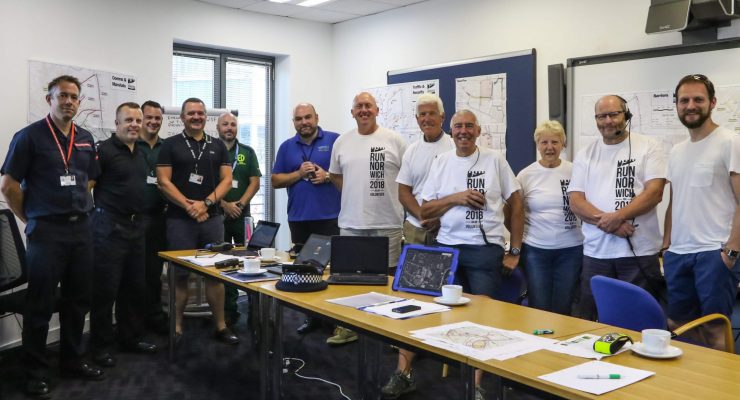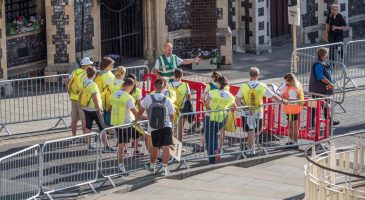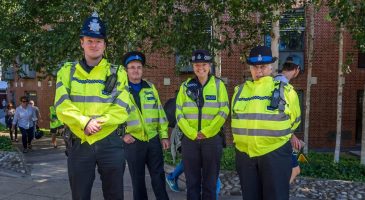Run Norwich 2024 results
Check out results from Run Norwich 2024!

Story added: 3rd July 2019
Tucked away in a small boardroom overlooking Millennium Plain and hidden away from public view is a team of people whose work on race day is essential, but almost entirely unseen.
Through a network of four radio channels and over 200 individual radios, the control centre – known as the Joint Operations Centre (JOC) – is the hub of decision making on race day.
The deployments of over 450 volunteers and staff are controlled from here, along with the coordination of traffic management, security, first aid and emergency services across the city.
Heading up the team is Run Norwich course manager Adey Ewing.
During 31 years in the Norfolk Constabulary, one of Adey’s roles was to lead the coordination of security and traffic management for all major events, which included being the match commander at Norwich City Football Club for seven seasons.
A passionate runner, with a strong involvement in the local running community, he is an integral member of the Run Norwich team and is the brains behind the race route.
For Adey, only the Millennium celebrations match the number of road closures and logistical challenges that Run Norwich creates.
He says: “When you break it down to its simplest form, our challenge is this: can we bring 7,500 runners and over 20,000 spectators into the city and get them home safely? At the same time, can we make the city function as close to normality as possible?”
The day begins at 4am for Adey and his team. The main challenge on race day morning is ensuring the course is “race ready”. He starts by driving the route, looking for any obstructions or course hazards that have arisen overnight.
“The evening economy is still flourishing at 4am in the morning, so it can be interesting!”



Detail is key here. Hazards can range from the seemingly trivial (discarded rubbish on the course) through to a major course obstruction such as an illegally parked vehicle.
At 6am, with the build of the course in its final stages the JOC goes live and road closures begin to come into effect.
“It’s a major logistical operation for the team. To make the course safe for our volunteers, runners, residents and spectators, we close roads at 42 different points, essentially restricting traffic from the whole city centre.”
Adey is joined in the JOC by ex-colleagues from his time in the Force, among them Stu Francis, Martin Jermy and Mike Coley, who all volunteer their time and expertise. Between them, and representatives from the Police, Ambulance, Fire service, and the first aid provider they coordinate all communications and responses to all issues that may arise.
“The JOC is essentially a dynamic decision making forum. We have to solve problems in real time, and not just ones confined to the race. While the race is going on, the city still has to operate as normal in the event of an emergency.”
Through the network of radio marshals, every section of the course is covered by radio contact. Every hazard identified is reported into the JOC, and a response taken to resolve it.
Adey explains how this works: “Every part of the course is broken down into four coloured zones and then into separate sections. Each section has a communications marshal with a unique call sign from the phonetic alphabet that identifies their zone and section.
“So if comms marshal ‘Yankee Two Zero’ reports that a runner has become unwell, for example, the team at the JOC know exactly where this is down to a few metres, and we can then coordinate the appropriate response.”
The team’s emergency-response handling was given its biggest test in 2017, when a runner, Tim Warner, suffered a cardiac arrest just 300 yards from the finish line.
The incident was instantly reported to JOC and a medical team directed to the incident.
A swift response from an off-duty paramedic and spectator Dale Gedge meant Tim was receiving CPR within seconds of collapsing, with the medical team arriving with a defibrillator shortly after.
Thankfully, the story had a happy ending and Tim made a full recovery after major surgery for an unusual heart condition – even managing to complete the race last year.
For Adey, aside from the success stories such as Tim’s, one of the sweetest satisfactions is how quickly the city returns to normality following the race.
“By 1pm the city is more or less as it is on a regular Sunday afternoon. Save for a few runners milling around the city with their medals around their necks, you might not even know a race with thousands of runners and spectators had taken place that morning.”
9th April 2025
Enter the Mortgage Advice Bureau Corporate Challenge 2025
20th March 2025
Entries for Run Norwich Junior 2025 will open soon